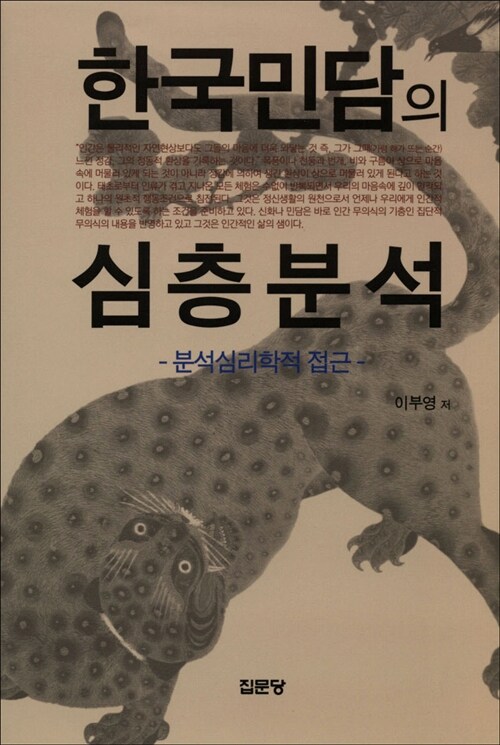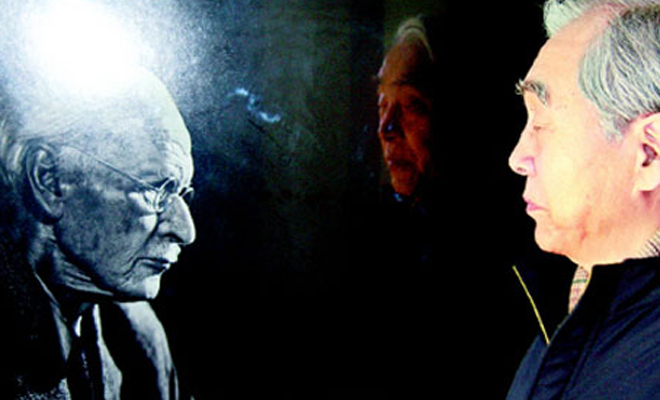한국민담의 심층분석 - 2판
이부영 (지은이)집문당2008-12-20


한국신화/전설/민담 주간 21위, 인문학 top100 4주|
Sales Point : 807

책소개
정신과 전문의가 우리 나라 민담에 나타난 우리 민족의 심성을 깊이있게 분석하는 책이다. 이 책은 우리 조상들의 심상이 민담 속에 어떤 형태로 스며들어 있는지, 그리고 일반 민중 속에 자리잡고 있는 우리의 근본 특성은 무엇인가를 흥미있게 밝히고 있다.
목차
Ⅰ. 분석심리학과 민담해석
1. 분석심리학이란 무엇인가
2. 민담과 무의식
3. 민담의 심리학적 해석
4. 맺는 말: 새로운 신화의 창조
Ⅱ. 한국민담 속의 갈등과 그 해결
1. 진짜와 가짜의 문제: 민담 <네가 누구냐>와 ‘그림자’의 문제
2. <지네장터>설화: 영웅원형의 한국적 전개
3. 호랑이와 세 아이: 악에의 대결과 우주적 해결
4. 한국민담에 나타난 악의 상과 대처양식
Ⅲ. 한국민담에 나타난 한과 여성상
1. 원령전설과 한의 심리
2. <선녀와 나무꾼>: ‘아니마’를 찾아서
3. 한국민담 속의 여성원형상: 한국여성의 <전통상>과의 관련에서
Ⅳ. 한국민담에 나타난 질병과 치료의 상징
1. 원형적 치료자의 한 유형: 두신무가를 중심으로
2. 한국민담 속의 질병과 치유
참고문헌
Contents
찾아보기
접기
저자 및 역자소개
이부영 (지은이)
저자파일
신간알리미 신청
서울대 의대(1959)와 동 대학원 졸업, 의학박사
신경정신과 전문의
스위스 취리히 체. 게. 융(C. G. Jung)연구소 수료(1966)
Jung학파 분석가. 국제분석심리학회 정회원
스위스 취리히 C. G. 융연구소 강사 역임
서울대학교 의과대학 정신과학교실 교수직(1969~1997), 동 교실 주임교수
미국 하와이 동서센터(East-West Center) 초빙연구원으로 문화와 정신건강 연구계획 참여
서울대학교병원 신경정신과 과장
대한신경정신의학회 회장 및 이사장
동아시아문화정신의학회 창립회장
한국분석심리학... 더보기
최근작 : <동양의학 연구>,<이부영 분석심리학 3부작 세트 - 전3권>,<자기와 자기실현 (양장)> … 총 34종 (모두보기)
출판사 제공
책소개
우리 나라 민담에 나타난 우리 민족의 심성을 정신과 전문의가 깊이 있게 분석하고 있다. 우리 조상들의 심상이 민담 속에 어떤 형태로 스며들어 있나, 그리고 일반 민중 속에 자리잡고 있는 우리의 근본 특성은 무엇인가를 흥미있게 밝히고 있다.
북플 bookple
이 책의 마니아가 남긴 글
친구가 남긴 글
내가 남긴 글
친구가 남긴 글이 아직 없습니다.
마니아
감순

저자의 분석심리학과 분석심리학 탐구 3부작을 읽고 이 책을 읽었는데 조금 실망스럽습니다. 민담을 읽음으로써 예감하게 되는 어떤 것 이상으로 분석이 이루어지고 있다고 보이지가 않았습니다. 미진한 느낌이랄까.
우끼끼 2012-03-27 공감 (2) 댓글 (0)
Thanks to
공감
우리나라민담분석중융적시각으로풀어낸논술로는최고의정성과전문성을보이고있다/방대한비교민속적자료를분석하면서융의이론을겸허하게적용하는속깊은혜안이일품이다/융저작선을비롯융관련학문을공부하는이라면자신의삶을융적으로성찰할것인데구체적인임상사례로삼을수있을것이다/역술가들이여융을읽자!
게라심 2014-12-09 공감 (0) 댓글 (0)
Thanks to
공감
마이리뷰
구매자 (1)
전체 (1)
리뷰쓰기
공감순

한국인의 심층
한국인의 심층을 민담을 통하여 들여다본다. 저자가 인용하듯이 프란츠 여사의 말씀대로 민담의 심층심리 해석은 일률적일 수 없으며 해석자가 적극적으로 구성해내는 대상이다. 저자는 프란츠 여사가 루마니아 고양이 민담 해석에서 보인 토대를 고스란히 옮겨 우리 민담에 적용한 듯이 보인다. 아시아인 해석자가 보일 수 있는 반응이 다소 축소된 인상이다.
마일즈 2009-09-27 공감(0) 댓글(0)
Thanks to
공감

 한국융연구소에 걸린 칼 구스타브 융의 사진을 바로보고 있는 이부영 원장 정신분석학의 권위자는 ‘귀신’의 존재를 어떻게 볼까.
한국융연구소에 걸린 칼 구스타브 융의 사진을 바로보고 있는 이부영 원장 정신분석학의 권위자는 ‘귀신’의 존재를 어떻게 볼까. 서울 성북동 한국융연구원 인근의 간송미술관에서 선 이부영 원장
서울 성북동 한국융연구원 인근의 간송미술관에서 선 이부영 원장  이부영 서울대 명예교수
이부영 서울대 명예교수


 Wikimedia Commons has media related to
Wikimedia Commons has media related to  Wikiquote has quotations related to
Wikiquote has quotations related to